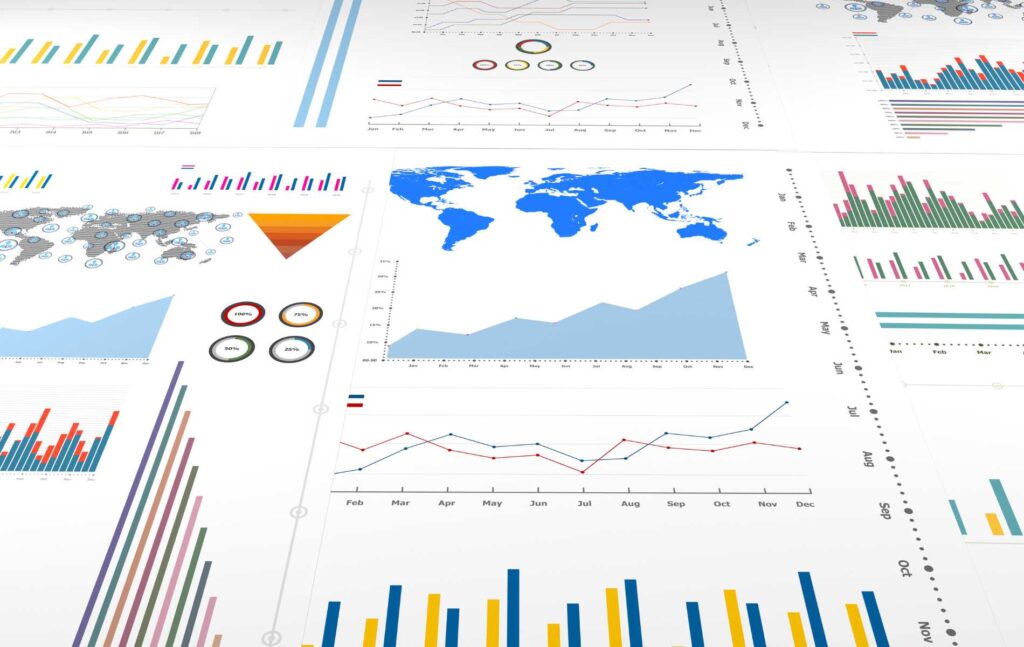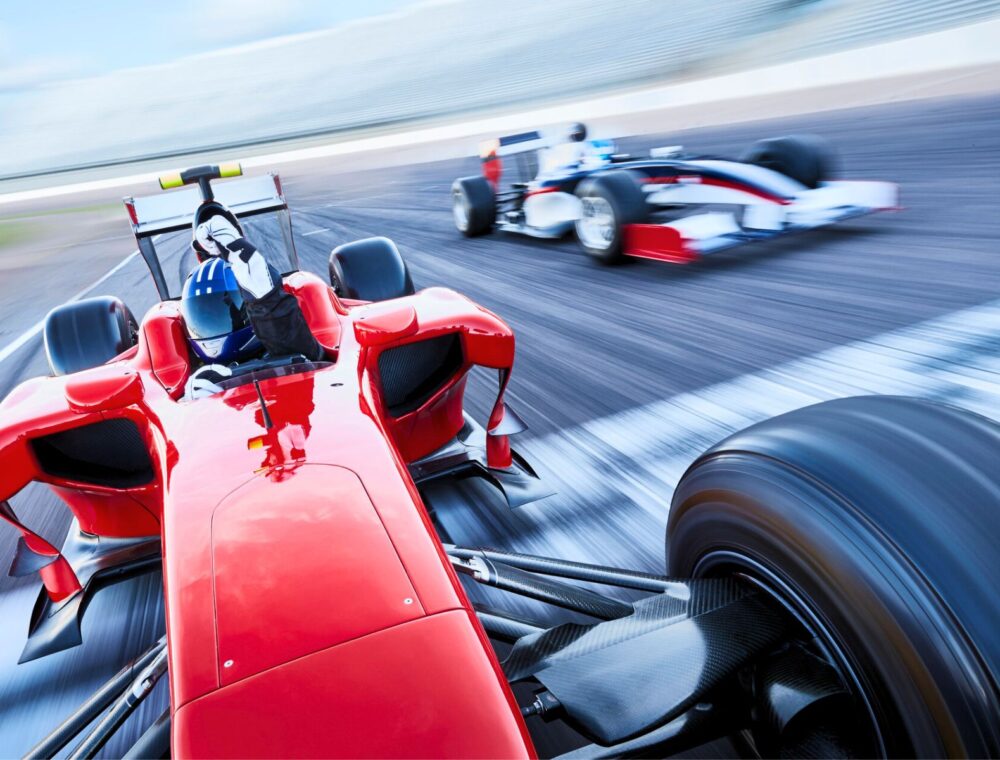Understanding marketing terms can sometimes feel like you are learning a new language. The sheer volume of industry-specific terms can be baffling, making it tough to keep up with the conversation. But that’s where our marketing dictionary can help.
Our marketing dictionary will help you understand these terms, and their meanings and provide examples of when they are used.
Marketing Dictionary
A/B Testing
A technique where you compare two versions of something to see which one performs better.
For example, an estate agent might run two adverts at the same time with different images, one with an external property photo and the other with an internal property photo, and compare which one performs better.
Ad Copy
Text that is included in an advertisement.
Algorithm
A set of rules used by search engines and social media platforms to rank and display content. These set of rules can change regularly.
Analytics
The process of tracking and analysing website traffic, click performance, user behaviour, campaign performance and more.
Backlink
Also known as an inbound link, a backlink is a link from an external website linking to your website.
Bounce Rate
The number of people who take no further action after landing on a website.
It is calculated as a percentage by: ‘Total number of visitors who visited one page then left’/’Total number of visitors to your website’ x 100
A low bounce rate indicates that your webpage encourages people to take further action such as clicking on another webpage or clicking a CTA. In comparison, a high bounce rate suggests that you need to improve your webpage to encourage visitors to take further action.
Business to Business (B2B)
Companies that sell to other businesses.
Business to Consumer (B2C)
Companies that sell directly to consumers. Netflix, Nike and Pret are examples of B2C businesses.
Buyer Persona
A profile that represents your ideal clients. These personas are based on deep research of your existing and desired customers. Each buyer persona will include a name, demographic details, interests, and behavioural traits which are used
Different types of people buy products for different reasons, so often you create more than one buyer persona.
Call To Action (CTA)
Any form of text that prompts an individual to take a specific action. ‘Subscribe Now’ ‘Click Here’ or ‘Sign Up Today’ are all examples of CTAs.
Click Through Rate (CTR)
A metric that measures how often people click on a specific link compared to how often they view it.
It is calculated by: (‘Number of people who clicked on the link or ad’/ ‘Total number of people who viewed it’)
In other words: Clicks/Impressions
Content Management System (CMS)
A software system where businesses can build and manage a website without having to create it from scratch via coding.
Conversion Rate
Percentage of individuals who completed a desired action (a conversion). The higher your conversion rate, the more effective your content is.
It is calculated by: (‘Number of conversions’/’Number of visitors’) x 100
For example, an email was sent to 10,000 clients encouraging them to sign up for a webinar and of those 10,000 people, 500 clicked through to sign up, your conversion rate would be (500/10,000) x 100 = 5%
Cost Per Click (CPC)
A metric that determines how much an advertiser pays each time someone clicks on their advert.
Customer Acquisition Cost (CAC)
A measurement of the cost associated with acquiring a new customer.
It is calculated by: (‘Total sales and marketing costs’/’Number of new customers acquired’) over a given period.
For example, if a company spends £20,000 on sales and marketing costs and gains 200 customers, the CAC would be 200/20,000 = £100.
Customer Relationship Management (CRM)
A term used mostly for a system companies of any size use to manage their interactions with existing and potential clients during the sales process.
Engagement Rate
A percentage of people that interact/engage with a piece of content.
It is most commonly used for social media to measure the amount of interaction (likes, comments and shares) a piece of content receives.
Evergreen Content
Material that remains valuable to readers regardless of when they read it.
For example, writing a blog about ‘How to start a vegetable patch’ is evergreen content as it offers steps that will remain valuable over a long period of time.
General Data Protection Regulation (GDPR)
A data protection law which regulates how the personal data of individuals within the EU is collected, stored, processed, and shared.
This applies to all businesses and non-compliance with GDPR can result in significant fines and penalties.
Hashtag
A hashtag is a word preceded by a hashtag symbol (#). These can include numbers, punctuation or emojis.
People use these on social media to categorise their posts and help them show more easily when people search for that term online.
For example, a local coffee shop might use #coffeeshop or #coffee when they post a photo of a cup of their coffee. Those then searching for coffee shops have a higher chance of seeing their post.
15% of consumers prefer to search on social media rather than search engines
Hubspot
HTML
HTML stands for Hyper Text Markup Language and defines the meaning and structure of web content.
Inbound Link
A link coming from another website to your website.
Infographic
A visual representation of information and data intended to present information quickly and clearly.

Key Performance Indicator (KPI)
A measurement used to track and assess a company’s performance against its business objectives.
Conversion rates or return on investment (ROI) are examples of KPIs.
Keyword
A keyword is a term used in marketing to describe a word or phrase people type into search engines when looking for specific information or content.
Landing Page
A web page that potential clients ‘land’ on once they have clicked through from an advert, email or other digital location.
Lead
An individual who is interested in your service or product.
Lifetime Value (LTV)
A measure of the average revenue that a customer will generate throughout their lifespan as a customer.
Long-Tail Keyword
These are longer, more specific terms, typically consisting of three or more words, such as ‘yoga classes for beginners in Islington’.
Because these tend to have a low search volume they have a higher chance of conversion.
Microsite
Microsites are small websites or single web pages separate from the main company website that focus on a select product, service or event rather than the entire company.
They each have their own domain and provide clients with more information on that selected product, service, or event than they would on the main website.
Mobile Optimisation
The process of adjusting your content, whether that be your website or newsletter, for mobile devices to ensure those using a mobile device can still access and read your content clearly.
No Follow Links
These are links with a special tag in the source code, which is not visible to the average user, that tells search engines not to pass any authority, or in other words, improve the search engine ranking, to that linked page.
For example, if you’re writing a blog and want to include a link to a low-quality website, you might use a no-follow link to avoid passing your website’s authority to that website.
Open Rate
Percentage of individuals who opened an email out of the number of people who received it.
On-Page Optimisation
Technique used to sure each page of your website is as search-engine-friendly as possible.
This includes using relevant keywords, using header tags properly and optimising title tags and meta descriptions.
Off-Page Optimisation
Techniques taken outside of your own website to improve its visibility and ranking in search engines.
This includes building backlinks (if you missed this, scroll to the top), guest blogging and more.
Page View
An occasion when someone loads or reloads a page on a website.
Page Visit
An occasion when someone lands on your website from another website or search engine, such as Yahoo, or Google.
Pay Per Click (PPC)
When a company puts an advert on an advertising channel such as Google Ads or Facebook, they have to pay-per-click. This means that when someone clicks on their advert, they have to pay a fee. The fee is determined by the advertising channel.
QR Code
Also known as Quick Response code. It is a barcode that is readable by select QR readers and cameras on mobile phones.
The QR code will then direct the user to the information encoded on the QR code. This could be text, a URL or other data.
For example, many companies use a QR code on their leaflets to drive traffic to their website. When someone scans the QR code they will be directed to the company’s chosen webpage.
Impression
The number of times an ad is viewed or displayed.
Return Of Investment
A measurement used to assess how profitable an investment has been.
It is calculated as a percentage by: ((‘Profit from Investment’ – ‘Cost of Investment’)/’Cost of Investment’) x 100.
For example, if a business invested £5,000 in an advertising campaign which generated £20,000, the ROI would be:
((20,000-5,000)/5,000) x 100 = 300%
Search Engine Optimisation
The process of improving where a website appears on a search engine such as Google, Bing and Yahoo.
Small to Medium Business (SMB)
Typically refers to companies that have 10 – 500 employees.
Short-Tail Keyword
These are more generic terms, consisting of one or two words, such as ‘shorts’, ‘shoes’ or ‘pizza’.
Because these terms have a high search volume, they are usually more competitive, and as a result, more expensive.
Unique Visitor
An individual who visits a website more than once over a certain period of time.
Unique visitors are often compared with overall website visits to understand the overall traffic on a website.
For example, if an individual visited a webpage 50 times, the webpage would then have 1 unique visitor and 50 website visits.
URL
Also known as Uniform Resource Locator.
It is essentially the address of a select webpage, image or document.
URLs contribute to SEO because when a keyword is searched, search engines will scour the internet, looking at what URLs include the keyword.
For example, if someone types in ‘what is SEO’ on Google, Google will search for those URLs featuring ‘what-is-seo‘.
User Experience (UX)
Refers to the overall experience a customer has with a business, including everything from how easy it is to use to how enjoyable the experience was.
User-Generated Content (UGC)
Any content including text, videos, images, audio etc. created and shared by people rather than by the brand itself.
User Interface (UI)
Parts of an app, device or website a user interacts with.
For example, on a mobile phone, the user interface includes the home screen, the icons you press to open apps, the buttons you press to make a call and the menus you scroll through to adjust settings.
Word of Mouth (WOM)
Information that has been passed from one person to another.
Marketing Dictionary
Save this marketing dictionary for future use. You never know when you might need it!
Want to take your marketing knowledge further? Call us today for a no-obligation discussion. Our team at Sirius Marketing would be happy to help.
